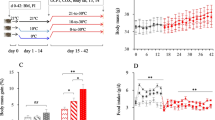Abstract
It was shown previously in infant rats (Rattus norvegicus) that the ability to produce heat in the cold using brown adipose tissue (BAT) is closely related to the ability to maintain cardiac rate. When the limits of BAT thermogenesis were exceeded, interscapular temperature (which reflects the temperature of the interscapular BAT depot) and cardiac rate fell together. As an extension of this earlier study, the relation between BAT thermogenesis and cardiac rate was examined here in the golden hamster (Mesocricetus auratus), a species whose young do not exhibit BAT thermogenesis until the end of the 2nd week postpartum. It was found that 3 to 12-day-old hamsters were unable to increase shivering or nonshivering thermogenesis in the cold and exhibited decreases in cardiac rate that proceeded in lock-step with decreases in interscapular temperature. In contrast, as the thermogenic capability of hamsters increased after 12 days of age, cardiac rate was maintained within narrow limits across a wide range of air temperatures. These results support the hypothesis that heat produced by BAT helps to warm the heart and thus aids in the maintenance of cardiac rate during cold exposure.
Similar content being viewed by others
Author information
Authors and Affiliations
Additional information
Accepted: 16 August 1997
Rights and permissions
About this article
Cite this article
Blumberg, M. Ontogeny of cardiac rate regulation and brown fat thermogenesis in golden hamsters (Mesocricetus auratus). J Comp Physiol B 167, 552–557 (1997). https://doi.org/10.1007/s003600050108
Issue Date:
DOI: https://doi.org/10.1007/s003600050108




